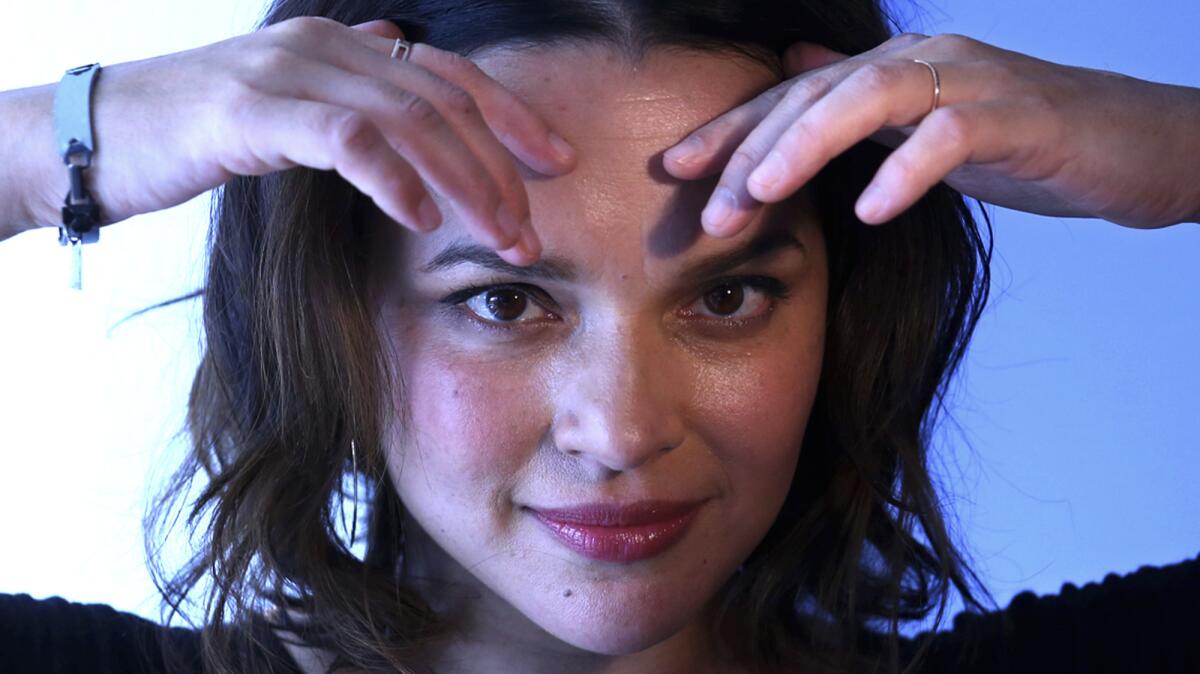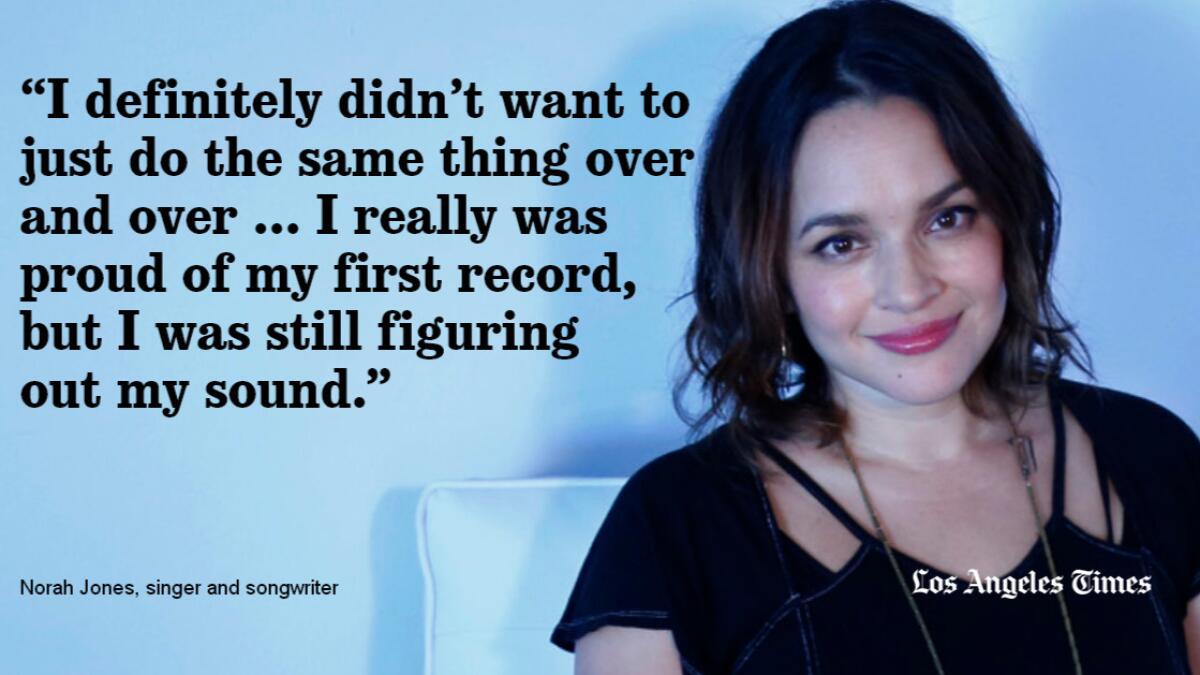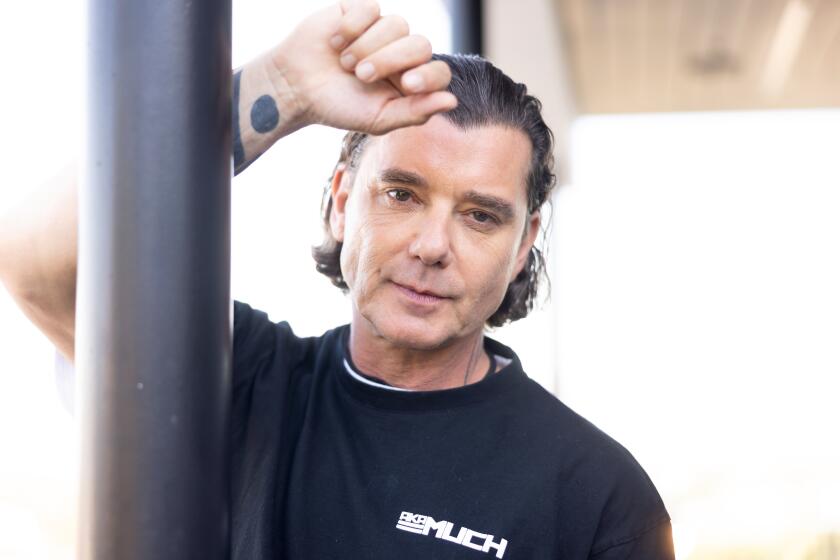Norah Jones looks forward to going back to a familiar sound with new album ‘Day Breaks’

- Share via
Even after colossal music industry success that can lead to a certain fluid view of time and deadlines, Norah Jones hates being late.
Although her meeting a few weeks back with reporters at one of the studios inside the Capitol Records building began only a few minutes behind schedule, she still apologized repeatedly. “I used to be the most on-time person I ever met and now I’m always like 10 or 15 minutes late,” she said.
“It’s more for me,” she explained with a laugh.
The idea of who Jones used to be has come up a lot in the run-up to her sixth album, “Day Breaks,” which was released Friday (she performs at the Greek Theater Oct. 25). With covers of standards by Horace Silver and Duke Ellington, and a backing band that at various points includes Dr. Lonnie Smith and Wayne Shorter, the album has been presented as “Norah Jones’ return to jazz,” or more specifically, “Norah Jones returns to the sound of her 2002 breakthrough, ‘Come Away With Me.’”
Though Jones doesn’t find that description inaccurate, it’s not her first choice. After writing on the guitar for her past few albums, she had lately been gravitating back to the piano, which played a prominent role in her debut. Then in 2014 she performed at the Kennedy Center as part of a 75th anniversary celebration for her label, Blue Note Records, with an all-star lineup that included Shorter, pianist Jason Moran and drummer Brian Blade.
And that got her wheels turning.
See the most-read stories in Entertainment this hour »
“I kind of tiptoed around [the idea] for awhile,” she said, explaining she had some hesitation about calling out of the blue. “I just wanted to play with Brian so bad because I wanted to do a few songs that were more ... jazz, maybe? Which is a loaded term,” she said.
That label didn’t sit right with her in the “Come Away With Me” days, but she doesn’t mind it as much now, explaining that it came from a protective instinct for a genre she loves. “It was more about being a former jazz snob in high school and college and wanting to correct people,” she said. “I was like, ‘No, you’ve got to go listen to some really great jazz now.’ This is not what it is, necessarily. Go listen to ‘In a Sentimental Mood’ with John Coltrane and Duke Ellington.”

Jones worked on songs here and there at her home in New York City before going in the studio with Blade and bassist Chris Thomas, which eventually expanded to include Shorter with his bassist John Patitucci, among others. But for all her intentions of exploring a genre where many people believe she began, parts of the album kept drifting across categories in a way that resembles, well, a Norah Jones record.
“She has a sound. No matter what she sings,” said Shorter, reached by phone at his L.A. home. “Ella Fitzgerald had a sound, Billie Holiday had a sound. Bing Crosby had a sound.
“If you go through the arc today, most of the sounds are like people on the highway sounding like the person in front of them,” he added. “People who took the trail less trodden – there’s very few people on that trail but that trail took them more places.”
Shorter’s bright, twisting tone can be heard on the purring ballad “Burn” (co-written by Jones with Sarah Oda) as well as a poignant cover of Silver’s “Peace” and a hushed take on Ellington’s “Fleurette Africaine,” which is the album’s most delicate moment with Jones on piano and humming the song’s hazy melody before giving way to Shorter.
“I was listening to [that song] a lot trying to get some juju from it. ... Because I wanted something cool like this to play with Wayne. Then in the end I just thought, we’ll just cover the song,” Jones said.
“Norah has grown more into who she is,” said Blade, who also played on “Come Away With Me.” “Not that she wasn’t confident from the beginning, but just in terms of in the studio and capturing performances, she worked in a very holistic way. ... She’s looking for a band performance, which is great.”
A country-tinged cover of Neil Young’s “Don’t Be Denied” gains a darker energy with a gender-flipped main character wearing “white chucks” instead of bucks, and then there’s the R&B-tilted early single “Flipside,” which was partly inspired by Les McCann’s 1971 soul-jazz classic, “Compared to What.”
Led by Jones’ driving piano, the brassy track includes the line “I finally know who I’m supposed to be,” a detail that easily stands out among those looking for artistic admissions in lyric sheets. Upon hearing the idea, Jones grins and sinks into the sofa.
“That’s not all about me!” she protested, though she’s not surprised, either. “I thought that, ‘I should change it to third person,’ but I was like, ‘Nah, I don’t really care.’ People take everything in such a different way.”
Disregarding expectations has been a theme in Jones’ career since “Come Away With Me” threatened to turn her into Adele for the early ’00s, complete with diamond sales numbers and an armload of Grammys. But she seldom looked back to that formula. Subsequent albums tilted more toward country, and her most recent record, 2012’s “Little Broken Hearts,” ventured into dark electro-pop with the help of producer Danger Mouse. That marked just one stylistic shift that year.
She also released a second album with her country trio the Little Willies, recorded an album-length tribute to the Everly Brothers with Green Day’s Billie Joe Armstrong and teamed with Oda to sing on the bawdy hip-hop goof “Dealbreaker” in a clip by a trio dubbed White on Rice. While these moves look like attempts to break with preconceptions about her music, Jones said it wasn’t as conscious as that.
“I definitely didn’t want to just do the same thing over and over,” Jones said as she stirred a cup of tea. “And I really was proud of my first record, but I was still figuring out my sound. We definitely hit upon it, but I think that I was interested in still exploring.
“I knew what people’s general image of me was. I don’t think I felt the need to completely change it,” she said, and then paused.
“Maybe in the beginning I did a little bit. I think more than anything I just tried to not let it define me. I didn’t have to let it define me.”
Follow me over here @chrisbarton.
More to Read
The biggest entertainment stories
Get our big stories about Hollywood, film, television, music, arts, culture and more right in your inbox as soon as they publish.
You may occasionally receive promotional content from the Los Angeles Times.











